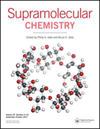15种药物抗菌防腐剂与大环葫芦[7]脲和对磺托基[4]芳烃的水相容性
IF 2.6
4区 化学
Q3 CHEMISTRY, MULTIDISCIPLINARY
引用次数: 1
摘要
摘要:采用1H NMR研究了15种用于液体/半固体药物剂型的抗菌防腐剂与大环葫芦[7]脲(CB[7])和对磺atocalix[4]芳烃(sCX[4])的相容性。如果没有证据表明形成主-客体复合物,则认为防腐剂与其中一种或两种大环相容。8种防腐剂(苯甲酸、乙醇、甘油、对羟基苯甲酸甲酯、山梨酸钾、丙二醇、乙二胺四乙酸钠和焦亚硫酸钠)被确定与CB[7]和sCX[4]相容。三种防腐剂(苯扎氯铵、氰胺和氯己定)与任一种大环均不相容,而氯丁醇和氯甲酚与sCX[4]相容,但与CB[7]不相容。苯氧乙醇与sCX不相容[4],但可能与CB不相容[7],这取决于与葫芦脲一起使用的防腐剂的浓度。最后,丙酸钠与sCX相容[4],但只可能与CB相容[7]。图形抽象本文章由计算机程序翻译,如有差异,请以英文原文为准。
Aqueous compatibility of 15 pharmaceutical antimicrobial preservatives with the macrocycles cucurbit[7]uril and para-sulfonatocalix[4]arene
ABSTRACT The compatibility of 15 antimicrobial preservatives used in liquid/semi-solid pharmaceutical dosage formulations with the macrocycles cucurbit[7]uril (CB[7]) and para-sulfonatocalix[4]arene (sCX[4]) was examined by 1H NMR. A preservative was deemed to be compatible with one, or both, of the macrocycles if there was no evidence of host-guest complex formation. Eight preservatives (benzoic acid, ethanol, glycerine, methyl paraben, potassium sorbate, propylene glycol, sodium ethylenediaminetetraacetic acid, and sodium metabisulfite) were determined to be compatible with both CB[7] and sCX[4]. Three preservatives (benzalkonium chloride, cetrimide, and chlorhexidine) were determined to be not compatible with either macrocycle, whereas chlorobutanol and chlorocresol were found to be compatible with sCX[4] but not with CB[7]. Phenoxyethanol was incompatible with sCX[4] but possibly incompatible with CB[7] depending on the concentration of the preservative used with the cucurbituril. Finally, sodium propanoate was compatible with sCX[4] but only possibly compatible with CB[7]. Graphical abstract
求助全文
通过发布文献求助,成功后即可免费获取论文全文。
去求助
来源期刊

Supramolecular Chemistry
化学-化学综合
CiteScore
3.60
自引率
3.00%
发文量
5
审稿时长
2.7 months
期刊介绍:
Supramolecular Chemistry welcomes manuscripts from the fields and sub-disciplines related to supramolecular chemistry and non-covalent interactions. From host-guest chemistry, self-assembly and systems chemistry, through materials chemistry and biochemical systems, we interpret supramolecular chemistry in the broadest possible sense. Interdisciplinary manuscripts are particularly encouraged. Manuscript types include: high priority communications; full papers; reviews, and; Methods papers, techniques tutorials highlighting procedures and technologies that are important to the field. We aim to publish papers in a timely fashion and as soon as a paper has been accepted and typeset it will be published in electronic form on the Latest articles section of the website. The two most important review criteria are that the paper presents high-quality work that fits generally into the broad spectrum of activities in the supramolecular chemistry field. Under normal circumstances, Supramolecular Chemistry does not consider manuscripts that would be more suitable in a highly specialized journal. This includes, but is not limited to, those based mostly or exclusively on topics such as solid state/X-ray structures, computational chemistry, or electrochemistry. .
The two most important review criteria are that the paper presents high-quality work that fits generally into the broad spectrum of activities in the supramolecular chemistry field.
 求助内容:
求助内容: 应助结果提醒方式:
应助结果提醒方式:


